Reviews by Eloquence
Are we born with brains that are blank slates waiting only to be filled with experience? And if so, why is it so difficult to simulate that same experience in a computer? Why can a sophisticated AI be easily tricked into thinking that a cat is guacamole or that a Granny Smith apple is an iPod? How have human brains managed to adapt to the diversity of environments across the globe, from the Stone Age to the Space Age?
In How We Learn: Why Brains Learn Better Than Any Machine … for Now, French neuroscientist Stanislas Dehaene shows that the “blank slate” hypothesis does not withstand scrutiny. Our brains are equipped, from birth, with specialized neural circuits that shape a child’s intuitions about physics, arithmetic, geometry, and probability.
Dehaene cites a large body of research (including his own) that shows how young infants’ brains make sense of the world using this “core knowledge”. This research has forced a re-appraisal of older psychological models that have become popular wisdom:
Incidentally, these results overturn several tenets of a central theory of child development, that of the great Swiss psychologist Jean Piaget (1896–1980). Piaget thought that young infants were not endowed with “object permanence”—the fact that objects continue to exist when they are no longer seen—until the end of the first year of life.
He also thought that the abstract concept of number was beyond children’s grasp for the first few years of life, and that they slowly learned it by progressively abstracting away from the more concrete measures of size, length, and density.
In reality, the opposite is true. Concepts of objects and numbers are fundamental features of our thoughts; they are part of the “core knowledge” with which we come into the world, and when combined, they enable us to formulate more complex thoughts. [p. 58]
Brains vs. Machines
Like a budding scientist, an infant’s brain forms predictions about the world and then adapts its wiring based on whether the predictions match reality. This neuroplasticity is powerful, but it is highest during early sensitive periods, and dependent on innate cognitive skills—a number sense, the ability to detect faces, to acquire languages, and so on.
Dehaene contrasts this with the current generation of artificial networks, which are closer to a “blank slate” on which the characteristics of a training dataset are gradually inscribed. As a result of this naive approach, AIs lack the human brain’s multifaceted reasoning skills—”for now”, as the book’s subtitle puts it.
Hinting at what tomorrow may bring, Dehaene cites examples of artificial neural networks modeled after human cognition. For instance, a 2008 algorithm for predicting the optimal structural representation of various datasets “rediscovered” human knowledge representations like the tree of life.
One may quibble with the author’s assertion that human brains learn “better” than machines, given that the latter have already excelled in specific domains. Just ask Go player Lee Sedol, who retired from professional play and called AI “an entity that cannot be defeated”.
A Theory of Learning
But the focus of the book are humans, not machines. The author’s goal is nothing less than a theory of learning that teachers, parents, and students can apply in practice. He suggests a model based on “four pillars of learning”: attention, active engagement, error feedback, and consolidation.
From these four pillars he develops concrete recommendations for educators. Many of them may match the instincts of progressive teachers: anxiety and stress prevent learning; students need to be engaged as individuals; sleep is essential. However, Dehaene is highly critical of unassisted discovery learning and the popular idea of learning styles.
Dehaene does not take a one-sided view in the “nature versus nurture” debate; instead, he explains the complex interplay between our biology and the world we inhabit. Biological evolution has placed constraints on us, but it has also allowed us to reason about the workings of our own brains, and to journey to other planets.
The Verdict
As a whole, I highly recommend Dehaene’s book. As befits the subject, he is a great (occasionally witty) teacher who uses straightforward explanations and illustrations in order to systematically advance the reader’s understanding of a complex subject.
While I found the author’s level of certitude—when he talks about animal intelligence or learning styles, for example—a bit off-putting at times, that too can be the mark of a teacher in love with their subject. It is a passion he successfully passes on to the reader.
If On A Winter’s Night, Four Travelers is a gift—literally. The indie game by Laura Hunt and Thomas Möhring is completely free, but you could easily mistake it for a commercial title. Its pixel art compares favorably both to classic point and click adventure games by LucasArts, and to modern ones like Kathy Rain. Möhring’s other credits include stunning concept art for the Netflix show The Queen’s Gambit, and each scene in the game feels like a small work of art in its own right.
The four titular travelers meet at a masquerade ball that takes place on a train in the late 1920s. Most of the story is told through flashbacks in which you experience a defining episode in the life of one of them. Behind their masks are troubled souls—as the player, can we only experience their stories, or change them? Like Italo Calvino’s book that inspired the game’s title, the game suggests that we interrogate it, not merely consume it.
This is not a lighthearted romp—think I Have No Mouth, But I Must Scream, not Monkey Island. You’ll be confronted with themes like mental illness and homophobia, and with graphic depictions of violence. Hunt and Möhring invite us to put on a mask and imagine the lives of these characters, whose worlds come alive in the game’s art and music. For the soundtrack, the developers have drawn on freely available recordings of classical music and songs from the depicted era.
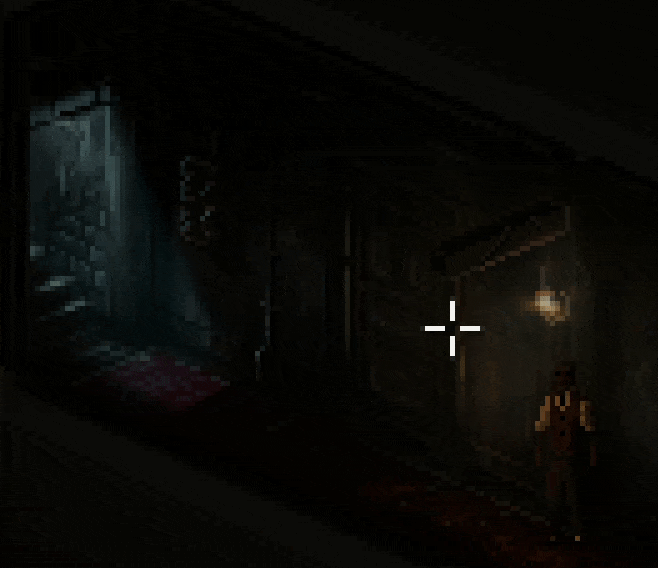
Lighting effects and subtle animations make even small scenes, like this brief encounter in a hallway, highly memorable. (Credit: Laura Hunt and Thomas Möhring. Fair use.)
There are small puzzles you have to solve to advance in the story, but none are likely to stump you for very long. That’s in part because there’s no inventory—you occasionally have to pick up an item, but you then immediately use it elsewhere in the scene. It’s point and click reduced to its essence.
With these simple mechanics, the game achieves surprising depth. For example, in the first story, you choose whether to interpret a telegram you have received from a lover positively or negatively. Depending on your choice, many subsequent interactions and observations will be different. In another story, you have to pay attention to sounds and voices instead of hunting for pixels.
Hunt and Möhring have made it clear that they do not want to be paid for the game, but they have suggested that an artbook and soundtrack may become available for purchase at a later date. If On A Winter’s Night, Four Travelers, then, is like a book you can pick up at any time from the library called the Internet. If you’re in the mood for a story that shows a little more darkness than light, I strongly encourage you to check it out.
Since the ascent of “casual” gaming, the explosion of online game publishing, and the rise of esports, video games have become mass culture for people of all ages. It’s only natural then to come across books like 1001 Video Games You Must Play Before You Die. The title a suggests grand curatorial ambition which the book never quite realizes.
It covers games across all devices and is organized chronologically, starting in 1971 (The Oregon Trail) and ending in 2013 (Bioshock Infinite). The book inexplicably focuses the bulk of its attention on titles from the 2000s (pages 416 to 921). So, prepare to read lots about the various Grand Theft Auto titles and Guitar Hero type games. On the other hand, Sierra Online’s entire catalog of adventure games is reduced to a single title (The Beast Within: A Gabriel Knight Mystery).
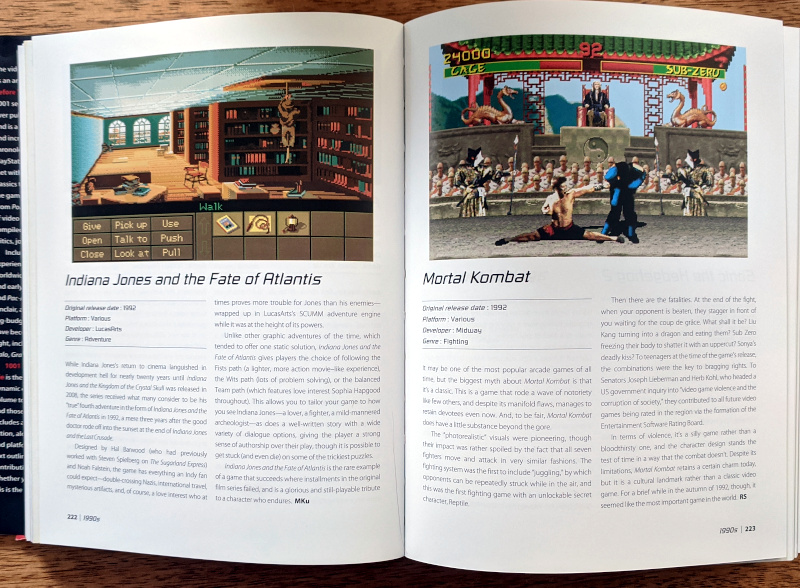
Most games in the book are as lavishly illustrated as the ones visible here. Some reviews, however, are entirely without screenshots. (Credit: Universe Publishing / Quintessence Editions Ltd. Fair use.)
The reviews of each title include plenty of criticism (sometimes so much that one has to wonder why the game made the cut at all), but no scores. With a large number of contributing writers, the quality of the writing is inconsistent. Some authors do an excellent job capturing a game’s ambience, story and gameplay; others barely describe the game at all, dwelling instead on development history and other minutiae.
My biggest frustration was that some games were included without any screenshots whatsoever—and we’re not talking about text adventures here, but titles like Elite or Nintendogs. This is the exception, but it’s still a cardinal sin for this kind of book, and the reason I can only give it three stars.
All in all, I don’t regret keeping this hefty compendium on my shelf, but if you’re looking for video game curation done well (with a lot more love for older games), I would recommend checking out the many titles by Bitmap Books instead.
So, what is your robot going to look like? Will it be a box with eyes on wheels, a flying furry puppet, a spider-robot with 360-degree vision? Make your selection and be presented with—another screen of text.
Choice of Robots is a game by Choice of Games, a company that should not exist. At least not if gaming followed the conventional history in which video game genres are forged in the fire of one generation of computing hardware, only to be wiped out in the avalanche of the next. Text adventures? They have gone the way of the dodo and the cathode-ray tube, surely.
Not quite. In 2009, Choice of Games released “Choice of the Dragon”, a text-based adventure game that became a smash success on mobile devices. Since then, they have released more than 100 titles under the “Choice of” label. The company has also made its game engine available under a license that permits noncommercial use, and they publish an endless flow of user-created titles.
It’s hard to explain the appeal of “Choice of” games if you haven’t played one. So go ahead, and try the damn dragon game in your browser. While the games share similarities with “Choose Your Own Adventure” gamebooks (“to attack the dragon, turn to page 69”), they offer a much larger number of choices, track internal variables, and do other things that computers can and books can’t. One thing they don’t do: trying to parse text input (“GET LAMP”). If you’ve ever played an old school text adventure, the parser is the one thing likely to drive you bonkers, because typing the exact words the computer expects can be a stochastic nightmare.

Just a few paragraphs of text, next choice. A bit more text, next choice. The formula works beautifully to get you to read a book without realizing it. (Credit: Choice of Games / Kevin Gold. Fair use.)
Robots then! Choice of Robots author Kevin Gold knows 01 thing or 10 about them. An Assistant Teaching Professor at Northeastern University, he “received his PhD from Yale University in 2008 for research on how robots could learn the meanings of pronouns and other abstract words from examples.” Choice of Robots isn’t about pronouns, though—it’s more about fulfilling that fantasy of “conquering Alaska with your robot army” that you’ve always had. OK, you also do get to pick your robot’s pronouns.
You start the game designing your robot and then walk down your chosen path, to achieve your destiny as a reclusive robot tinkerer or a power-mad corporate overlady. Yes, those are the only two options. Just kiddding.
The game beautifully adapts to your decisions. If you want your Alaska fantasy, that’s what you’ll get (hey, no judgment). If you want a love story, that’s what you’ll get. If you want a tale in which hyperintelligent robots become good-natured shepherds of their obsolete human builders, that’s probably also what you’ll get, but ask your robot supervisor.
Aside from the romantic options being fairly limited—this ain’t a robot dating sim—none of these paths feel underdeveloped. Gold’s writing draws upon the real world (let your professor introduce you to the military-industrial complex), on myths and legends (dress up as Hephaestus at a party), on literary references (quote The Tempest at a funeral), and much more. It does so while staying lighthearted and unpretentious, even as Gold’s PhD ever looms in the game’s byline.
Choice of Robots may make you think about what the future holds, but most of the philosophical ground it visits is well-traveled. It’s in the nature of the game to not be morally prescriptive. In other words, you can be clearly quite evil, if that’s how you want to play it. As an interactive story, it’s a masterclass that’s sure to keep you entertained for a few hours. To send your flying muppet into the world, it’s well worth the six bucks.
The Last Birdling is a visual novel by indie developer Marcus “InvertMouse” Lam released in 2017, two years after Cursed Sight (review). It tells the story of the secretive relationship between two girls, a human named Tayo and a birdling named Bimonia. The birdlings are winged humanoid creatures that once dominated the wild—but after a great war with the humans, Bimonia and her mother may be the last birdlings alive.

As a young woman, Tayo is drawn further into the conflict between birdlings and humans. (Credit: InvertMouse. Fair use.)
A a child, Tayo befriends Bimonia in the forest near a human settlement. For both girls, their growing friendship is a chance to escape their protective and demanding mothers, and to experience the joy of discovering the world through the eyes of another. But humans still view birdlings as dangerous monsters. If Bimonia is spotted by the townspeople, the result will almost certainly be bloodshed—and Tayo will be branded a traitor for becoming a birdling’s friend.
As the player, your perspective alternates between the two protagonists, and you are prompted to make many small choices. As Tayo, do you swallow a rotten herb offered to you by Bimonia, even though it may make you ill? The effect of these choices is limited until the end, when the nature of the relationship between Tayo and Bimonia leads to one of five endings.
Regardless of your decisions, this is not a cheerful tale. While the game is generally not visually explicit, it includes textual descriptions of violence, death, and sexual assault.
A well-crafted tale
Technologically, The Last Birdling is a solid title that showcases InvertMouse’s growing mastery over the visual novel format. The characters are visually expressive and the game is well-paced, offering beautiful chapter transition screens as the story progresses. As a player, it’s easy to visit the different endings without re-reading old text.
The game attempts a fair bit of worldbuilding, including a glossary that fleshes out concepts touched upon in the story. The quality of the writing is sometimes uneven, but never distractingly so. As in some of InvertMouse’s other stories, the characters do have a tendency towards self-loathing that gets a bit tiresome.
The Last Birdling is a better title than Cursed Sight in almost every respect, but in spite of that, I found it less emotionally impactful. The ambiguous relationship between Bimonia and Tayo pulled me away from the characters to the larger themes of the story. As a result, even the most tragic events packed less of a punch.
Nonetheless, The Last Birdling is a good story. I would recommend it to fans of the visual novel genre, if you’re in the mood for a fantasy tale about forbidden friendship that visits some dark places. At $5 it’s a small price for a labor of love by a storyteller of maturing talent.
In Arrival of the Fittest (review), biologist Andreas Wagner made the compelling argument that life “finds its way” to solutions by way of neutral mutations. Through incremental changes, proteins can change shape gradually without losing their original function. As a population diversifies, natural selection can then identify those protein variants that have acquired entirely new, useful functions.
The book challenged a naive view of evolution, in which the vast majority of genetic mutations cause harm, and a small percentage of them confer an immediate survival benefit. The truth is that life needs to “play around” with neutral mutations to navigate the landscape of possible changes that may make a species more or less suited for survival.
In Life Finds a Way, Wagner applies this “landscape thinking” to all types of creative problem-solving. The first half of the book focuses on the concept of fitness landscapes, a limited but useful visual metaphor for how well-adapted specific genes (and the creatures they inhabit) are to their environment. The peaks in a three-dimensional landscape represent high levels of successful adaptation to the environment:
Visualization of a population of individuals evolving to become better suited for survival, i.e. “climbing a peak” in the fitness landscape. (Credit: Randy Olson and Bjørn Østman. License: CC-BY-SA.)
Natural selection marches steadily uphill. What prevents a population from being trapped on a small hill that represents an evolutionary dead end, an adaptation of limited usefulness that can’t be improved? Wagner breaks down how genetic drift (changes in frequency of specific gene variants), genetic recombination through sexual reproduction, and horizontal gene transfer in bacteria help individuals in a population slide or jump across the fitness landscape.
Wagner shows how potential energy landscapes in physics can similarly be used to map the possible configurations of molecules or crystals, and how gravity, thermodynamics and other physical forces push nonliving matter into stable (and often beautiful) configurations that represent valleys in the landscape.
Of mountains and molehills
In the second half of the book, Wagner applies landscape thinking to human creativity. He encourages us to visualize the map of creative solutions to a given problem (even if that “problem” is the composition of beautiful music) as a landscape with peaks and valleys. What does it take for a creative mind to climb mountains and avoid getting stuck on molehills of mediocrity?
The author enumerates many tools creative minds can use to traverse the landscape of ideas without getting stuck, including:
-
dreams
-
play
-
travel and exposure to other cultures
-
work with people from other disciplines
-
drugs.
As a positive model for cross-disciplinary work, Wagner cites the Santa Fe Institute, a renowned cross-disciplinary think tank where Wagner is an External Professor. (One way I hope they won’t be a model: even though the institute was only founded in 1984, its seven founders were all men, something Wagner does not remark upon.)
Into the badlands
Wagner harshly criticizes the obsession with standardized testing in the United States, and the rigid education approaches of South Korea and China. In his critique, he revisits familiar generalizations about “Western” and “Eastern” cultures, and seems to see “Eastern” cultures trapped in rigid uniformity, while situating the pinnacle of individual freedom in the United States.
Nations that want to nurture creative minds, Wagner argues, should reduce the negative consequences of failure—whether it’s for scientists applying for a research grant, or for entrepreneurs starting a business. Creative societies should be accessible to immigrants with diverse backgrounds, and recognize the benefits of diversity and individual freedom.
While Wagner pays lip service to the dangers of inequality, his analysis is stuck in a neoliberal frame of reference. Much more could be written about how an effective welfare state, a vibrant democracy, and alternatives to exploitative capitalism and intellectual monopoly rights (copyright, patents, etc.) are necessary to reap the benefits of human creativity for all people.
Instead, Wagner repeatedly cites Silicon Valley as an example for innovation, with the implicit assumption that the way to make a better world is to create more corporations like Facebook, Apple, and Tesla.
It’s worth remarking that Life Finds a Way was written before the COVID-19 crisis laid bare the utter incompetence of many “Western” governments, including the United States, in managing a pandemic. The landscape of ideas about COVID-19 is dotted with the creative edifices built by anti-vaxxers and ideologues, and landscape thinking alone seems like a very limited tool for getting humanity out of the badlands.
Thankfully, Wagner’s flurry of societal prescriptions is as brief as it is unimaginative. What we’re left with, then, is his argument to apply landscape thinking beyond physics and biology, providing an intellectual foundation for the value of letting our minds roam. That’s all it is—a foundation, one which I do hope other writers will build on.
Damn the Vek! Too stupid to communicate with, but smart enough to seek out human civilization wherever it is. In every timeline, the plague of giant insect monsters is close to wiping out what’s left of humanity. They breed underground and tunnel their way to the surface, only to bring death and devastation.
Insecticide won’t kill these bugs dead, but a squad of piloted battle mechs might. Or might not. Fortunately for the multiverse, humanity has learned how to travel between parallel universes, to attempt to rescue as many timelines as possible from the Vek.
Once more Into the Breach then, with another squad! Released in 2018, the second title by Subset Games after FTL cemented the tiny indie studio’s reputation for excellence. It takes plenty of inspiration from legendary turn-based strategy games (Advance Wars especially comes to mind), but still feels fresh and unique.
Much of this is due to the tightness of gameplay and mechanics. Assemble your team. Click. Pick a scenario. Click click. And: you’re in the fight. The map fits on one screen. You place your units. The enemy moves. The enemy starts to attack—and now it’s your turn.
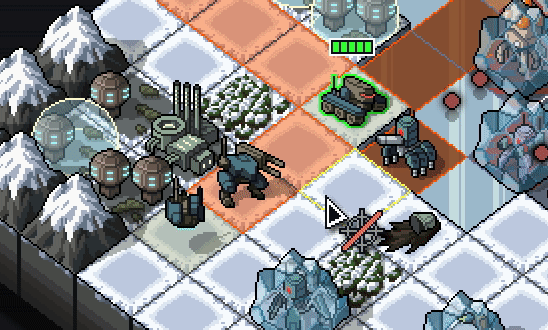
A member of the Zenith Guard, a charge mech, finds its target. (Credit: Subset Games. Fair use.)
Depending on your squad and each mech’s buildout, you can destroy units, push and pull them, create hazards, create shields, and more. The array of skills turns every round into a small puzzle. How will you prevent the enemy from damaging your units, or killing civilians in a building, or destroying strategic targets?
Miscalculate, and the Vek might end up taking down the energy grid—game over. It’s permadeath, sort of: you can take one of your pilots to the next timeline. Too bad for this one.
An Honest Roguelike
From a limited number of ingredients, the game cooks up a fresh set of scenarios for you on each run. Some maps are especially difficult to beat without taking some hits to buildings; any damage you take to the energy grid carries over to the next map. You have to make some strategic choices between battles—which battles to fight, which upgrades to install—but most of the game is tactics, tactics, tactics.
The difficulty level is not quite as punishing as that of FTL or other roguelikes that celebrate starting over as part of the fun. At normal difficulty, you may notch your first game victory after a few runs, perhaps even on the first try. The Vek are as stupid as they are relentless. But the game will produce enough brain twisters to keep you coming back.
When you manage to shove a nasty Vek into the sea, or cause a chain reaction of monsters killing each other, it’s quite the payoff. If that isn’t enough, the game rewards you with unlockable squads, experience points, upgrades, and ambient dialogue that never gets in the way.
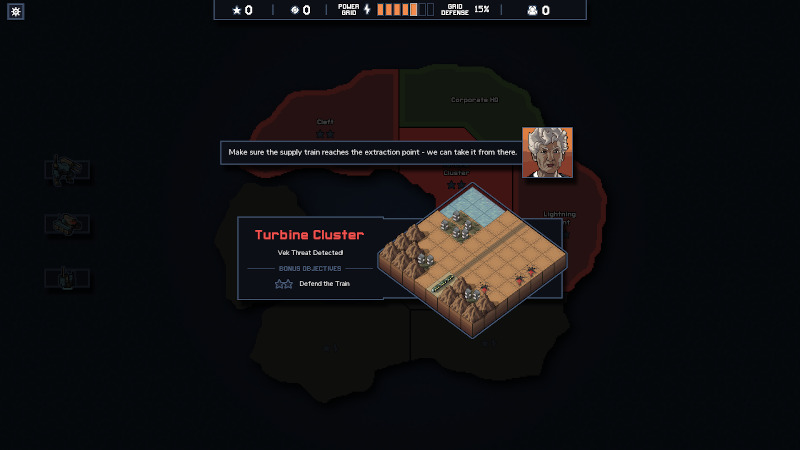
Mission briefings are terse, but there’s a large enough variety of objectives to keep things interesting. (Credit: Subset Games. Fair use.)
The Verdict
While it’s a very different game than FTL, it’s clearly built with the same design philosophy. The pixel art is more beautiful than FTL’s, but never extravagant; the UI provides help when it needs to and otherwise gets out of the way; moving your units feels as straightforward as moving the pieces on a chessboard.
In spite of the absurd premise and cartoonish physics (units can be encased in ice and unfrozen without damage), the game’s tone is mostly somber; even victory is just a brief reprieve in an endless war played out across universes. The fun is in solving the puzzles the random number generator throws at you and kicking some serious Vek butt. If that kind of turn-based strategy sounds like your cup of tea, you can’t go wrong heading Into the Breach.
Cursed Sight is a visual novel developed by Marcus “InvertMouse” Lam, an Australia-based indie developer. We meet the protagonist, Gai, at the age of 10 when he is sold by his parents to work as a servant for the king of East Taria, a fictional Asian kingdom. Gai becomes responsible for helping to protect the kingdom’s “treasure”—a young girl named Miyon born with dangerous abilities that King Lok is exploiting.
As the story progresses, Gai develops a friendship with Miyon and her caretaker, a young woman named Sasa. As Gai and Miyon grow older, they consider what kind of life may be possible beyond the captivity of the temple. Their decisions could cost them their lives, and they will certainly shape the future of the kingdom.
This is a mostly kinetic visual novel, meaning that you read it by clicking through it. There are 4 different endings, which you access through a couple of branch-points in the story where you do get to make choices.
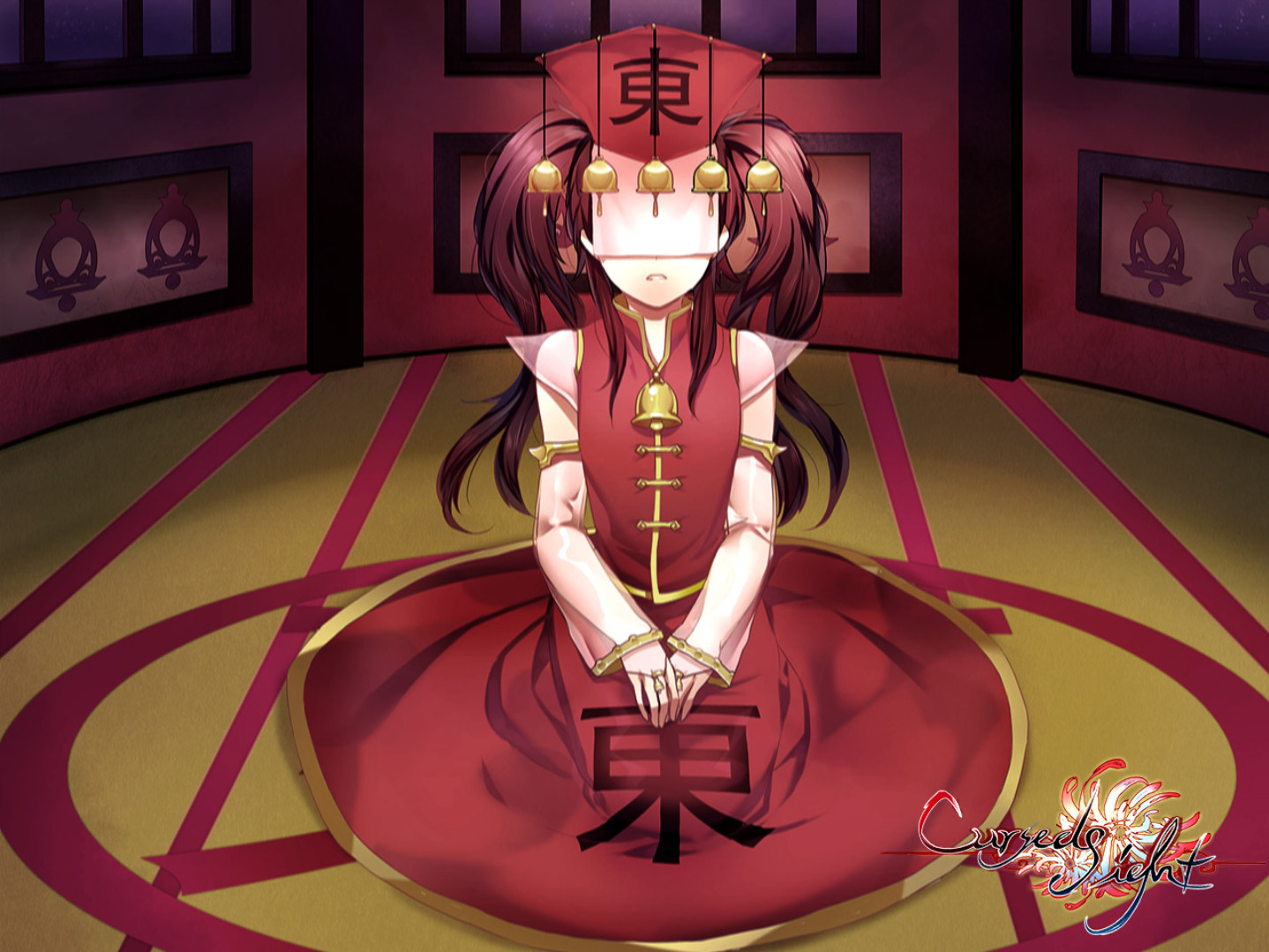
Miyon is a young girl who is held captive to exploit the mysterious power of her cursed sight. Beautiful screens like this one are used as segways between different chapters of the story. (Credit: InvertMouse. Fair use.)
The art is lovely, and the music, while repetitive, fits the setting. The story is not voiced. The writing is decidedly mixed. Gai never quite acts his age (his 10-year-old version is too adult, his adult version is too childish); some paragraphs really needed an editor; anachronistic references and expressions distract from the setting. The most cringeworthy example is this one:
Miyon had opened up so much that I worried the other servants, or even guards, might become interested in her. I would fight them all in a cage at the same time if they dared touch her. Well, maybe after I attached a chainsaw to my left arm.
(Yes, that’s a reference to a chainsaw in a game that is meant to be set in the distant past.)
The game is at its strongest when it conveys emotions and builds its characters. I certainly became invested enough to finish the story and to get to all four endings, and the story moved me to tears a couple of times. While the game is only of average quality overall, there’s the kernel of something lovely here, and I look forward to playing more of InvertMouse’s games in the future.
Bad writing grasps at your attention like a man grasping at straws; great writing seizes your attention and doesn’t let go. Eliza is a computer game, and its writing is firmly in the latter category; it has a story to tell, and the moment it begins telling it, you want to know how it ends.
This is a visual novel, a genre in which you typically click your way through an illustrated story and make a few choices along the way. You play as a young woman named Evelyn who, after a period of depression and burnout, starts a job working for an AI-based counseling service called Eliza (in homage to the 1966 chatbot of the same name).
Evelyn works as a proxy, a human face for the AI. Proxies are required to faithfully read their lines to customers—”don’t deviate from the script!” Some of the people Evelyn meets as a proxy are looking for treatment, some just want a person (or a machine, as the case may be) to talk to. The game uses this conceit to explore deeper questions about the role of technology in a capitalist society.
As an undercurrent, Eliza explores the culture of the tech industry. There’s the startup founder with the grand vision of “ending human suffering”, who seems to harass every female staff member he hires. There’s the idealistic young engineering manager who is starting to raise questions about the privacy practices of his employer. And there’s Evelyn’s friend Nora, a former programmer who is now freelancing and making electronic music.
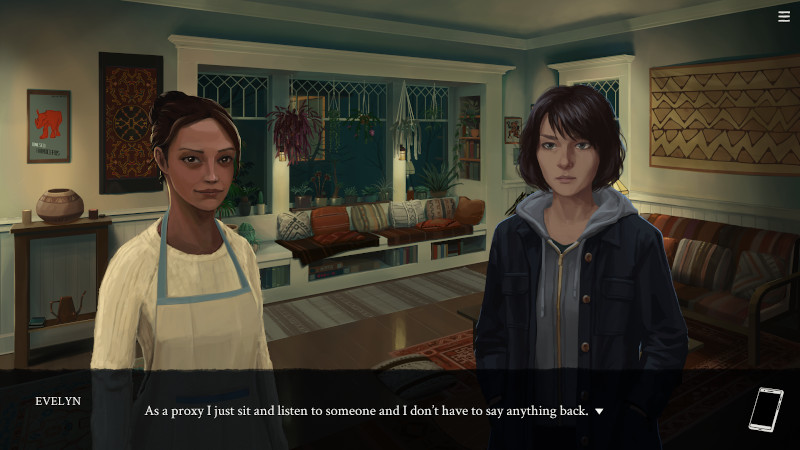
Evelyn (right) meets her colleague Rae for a cookie-baking session. (Credit: Zachtronics. Fair use.)
The game offers small choices throughout, but their effect tends to be very limited. In fact, when you act as the AI’s proxy during counseling sessions, the game deliberately takes away your choice to say anything other than the dialogue generated by the AI, occasionally forcing you to say “I’m sorry, I don’t understand the question” as if you yourself were an algorithmically constrained chatbot. It’s player frustration in service of the story.
At the end of the game, Evelyn must make a defining choice, which leads to one of several endings. The game does not punish or reward you for your choice with a “good” or “bad” ending; instead it concludes the story in a manner that suits the character you’ve chosen to become.
Eliza took me about 6 hours to complete, and that includes exploring the different endings. The dialogue is fully voiced by a cast of experienced voice actors. Backgrounds and character sprites are visually pleasing, but the graphics are completely static—facial expressions or poses don’t change, even when the dialogue suggests that they should.
The Verdict
Eliza falls a bit short on the “visual” side of being a visual novel due to its use of static images; as a game, some players will find its linearity and long sequences without significant player choices overly limiting. But as a story about the role of AI in society, it is gripping and timely. If the theme interests you, I recommend the game without reservations.
Every once in a while, I’m drawn to the tower defense genre, where you must dispatch with waves of enemies by building stationary defenses that fire on anything that moves in their proximity. It’s real-time-strategy reduced to the barest explodey foundations, with all action often taking place on a single screen. Unsurprisingly, the genre thrives on tablets and other mobile devices.
Cursed Treasure 2 differs from the stock formula mainly in two ways: You play as an evil overlord, and your enemies are trying to steal your stuff (gems in this case). If they steal all of it, you lose the level. That gives the player a more active role in the proceedings—you have to always keep one eye on those gemstones to prevent your enemies from absconding with them. If you have enough mana, you can summon a meteor to smush your opponents, or you can strike terror into their hearts to deter them.
After winning a level, you can play it in “night mode”, which restricts your placement options for towers to add a bit of difficulty; between levels, you can spend experience on assorted power-ups. All in all, the game offers enough variety to keep things interesting for a while—I put about a dozen hours into it.
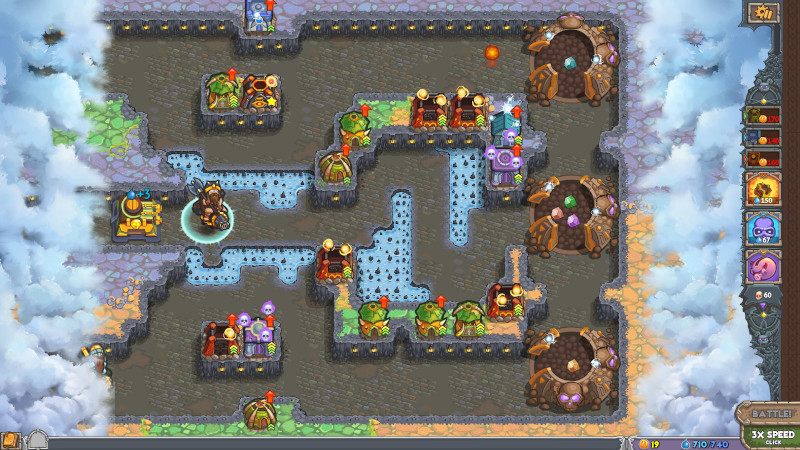
Fighting one of the bosses in the last level. (Credit: Armor Games Studios / IriySoft. Fair use.)
The downsides:
-
There’s no story to speak of, and some of the English text on the screen would have benefited from copyediting by a native-level English speaker.
-
The game crashed once on me, and it forget its savegames a couple of times (restarting the game again made them re-appear).
-
By the time you’re really comfortable with all the mechanics, the game is over; unless you’re a dedicated completionist, night mode just doesn’t offer enough to pull you back in.
Still, you can often pick this up for a dollar, and it’s a solid game with a decent Linux port. Recommended if you’re like me and occasionally just want to fill your screen with things that go boom.
